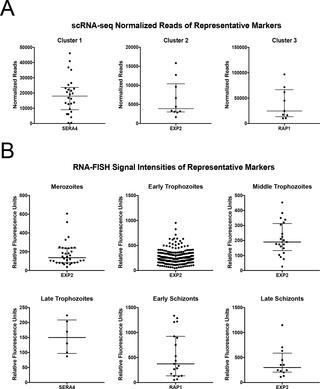当前位置:
X-MOL 学术
›
PLOS Genet.
›
论文详情
Our official English website, www.x-mol.net, welcomes your feedback! (Note: you will need to create a separate account there.)
Latent transcriptional variations of individual Plasmodium falciparum uncovered by single-cell RNA-seq and fluorescence imaging.
PLOS Genetics ( IF 4.5 ) Pub Date : 2019-12-19 , DOI: 10.1371/journal.pgen.1008506 Katelyn A Walzer 1, 2 , Hélène Fradin 2 , Liane Y Emerson 1, 2 , David L Corcoran 2 , Jen-Tsan Chi 1, 2
PLOS Genetics ( IF 4.5 ) Pub Date : 2019-12-19 , DOI: 10.1371/journal.pgen.1008506 Katelyn A Walzer 1, 2 , Hélène Fradin 2 , Liane Y Emerson 1, 2 , David L Corcoran 2 , Jen-Tsan Chi 1, 2
Affiliation

|
Malaria parasites follow a complex life cycle that consists of multiple stages that span from the human host to the mosquito vector. Among the species causing malaria, Plasmodium falciparum is the most lethal, with clinical symptoms manifesting during the intraerythrocytic developmental cycle (IDC). During the IDC, P. falciparum progresses through a synchronous and continuous cascade of transcriptional programming previously established using population analyses. While individual parasites are known to exhibit transcriptional variations to evade the host immune system or commit to a sexual fate, such rare expression heterogeneity is largely undetectable on a population level. Therefore, we combined single-cell RNA-sequencing (scRNA-seq) on a microfluidic platform and fluorescence imaging to delineate the transcriptional variations among individual parasites during late asexual and sexual stages. The comparison between asexual and sexual parasites uncovered a set of previously undefined sex-specific genes. Asexual parasites were segregated into three distinct clusters based on the differential expression of genes encoding SERAs, rhoptry proteins, and EXP2 plus transporters. Multiple pseudotime analyses revealed that these stage-specific transitions are distinct. RNA fluorescent in situ hybridization of cluster-specific genes validated distinct stage-specific expression and transitions during the IDC and defined the highly variable transcriptional pattern of EXP2. Additionally, these analyses indicated huge variations in the stage-specific transcript levels among parasites. Overall, scRNA-seq and RNA-FISH of P. falciparum revealed distinct stage transitions and unexpected degrees of heterogeneity with potential impact on transcriptional regulation during the IDC and adaptive responses to the host.
中文翻译:

单细胞RNA-seq和荧光成像未发现恶性疟原虫的潜在转录变异。
疟疾寄生虫遵循一个复杂的生命周期,该生命周期包括从人类宿主到蚊媒的多个阶段。在引起疟疾的物种中,恶性疟原虫是最具致死性的,在红细胞内发育周期(IDC)期间表现出临床症状。在IDC期间,恶性疟原虫通过先前使用种群分析建立的同步连续的转录程序级联进行。虽然已知单个寄生虫会表现出转录变异,以逃避宿主免疫系统或犯下性命,但这种罕见的表达异质性在人群水平上基本上是不可检测的。所以,我们在微流控平台上结合了单细胞RNA测序(scRNA-seq)和荧光成像,以描绘无性和性晚期个体寄生虫之间的转录变异。无性和性寄生虫之间的比较发现了一组以前未定义的性别特异性基因。根据编码SERAs,rhoptry蛋白和EXP2 plus转运蛋白的基因的差异表达,将无性寄生虫分为三个不同的簇。多个伪时间分析表明,这些特定于阶段的转换是不同的。簇特异性基因的RNA荧光原位杂交验证了IDC期间不同的阶段特异性表达和过渡,并定义了EXP2的高度可变转录模式。此外,这些分析表明,寄生虫在特定阶段的转录水平上存在巨大差异。总体而言,恶性疟原虫的scRNA-seq和RNA-FISH揭示了不同的阶段转换和意想不到的异质程度,对IDC期间的转录调控和对宿主的适应性反应具有潜在影响。
更新日期:2019-12-20
中文翻译:

单细胞RNA-seq和荧光成像未发现恶性疟原虫的潜在转录变异。
疟疾寄生虫遵循一个复杂的生命周期,该生命周期包括从人类宿主到蚊媒的多个阶段。在引起疟疾的物种中,恶性疟原虫是最具致死性的,在红细胞内发育周期(IDC)期间表现出临床症状。在IDC期间,恶性疟原虫通过先前使用种群分析建立的同步连续的转录程序级联进行。虽然已知单个寄生虫会表现出转录变异,以逃避宿主免疫系统或犯下性命,但这种罕见的表达异质性在人群水平上基本上是不可检测的。所以,我们在微流控平台上结合了单细胞RNA测序(scRNA-seq)和荧光成像,以描绘无性和性晚期个体寄生虫之间的转录变异。无性和性寄生虫之间的比较发现了一组以前未定义的性别特异性基因。根据编码SERAs,rhoptry蛋白和EXP2 plus转运蛋白的基因的差异表达,将无性寄生虫分为三个不同的簇。多个伪时间分析表明,这些特定于阶段的转换是不同的。簇特异性基因的RNA荧光原位杂交验证了IDC期间不同的阶段特异性表达和过渡,并定义了EXP2的高度可变转录模式。此外,这些分析表明,寄生虫在特定阶段的转录水平上存在巨大差异。总体而言,恶性疟原虫的scRNA-seq和RNA-FISH揭示了不同的阶段转换和意想不到的异质程度,对IDC期间的转录调控和对宿主的适应性反应具有潜在影响。


























 京公网安备 11010802027423号
京公网安备 11010802027423号